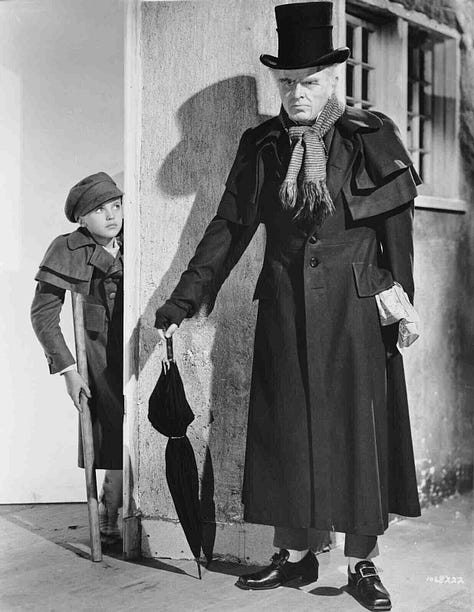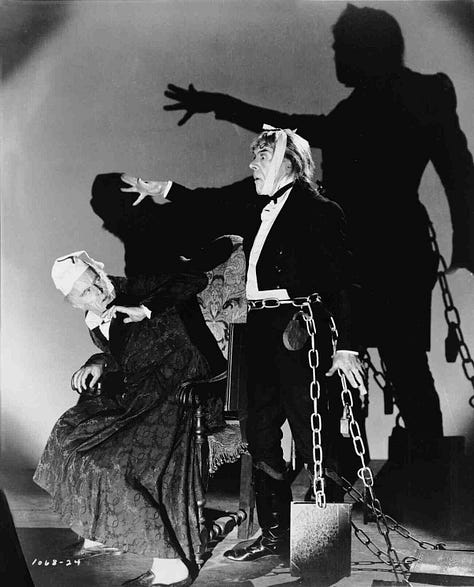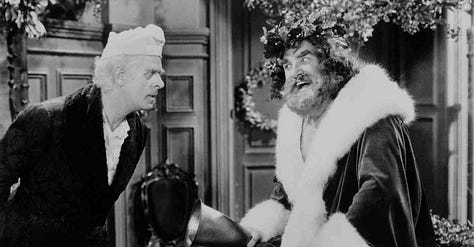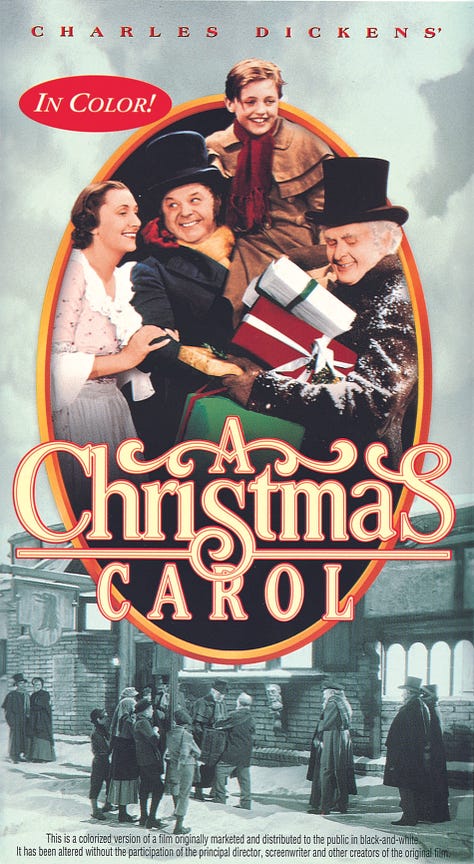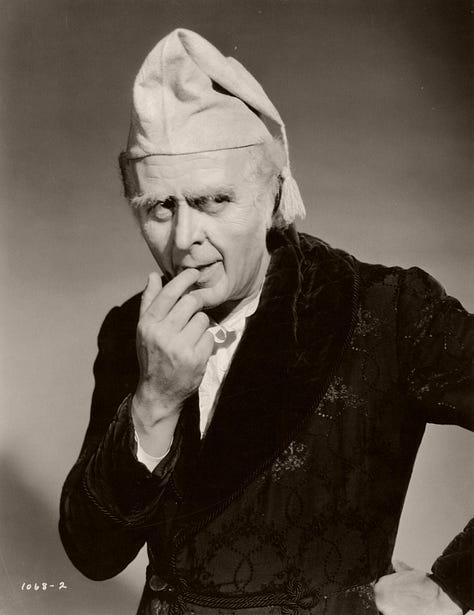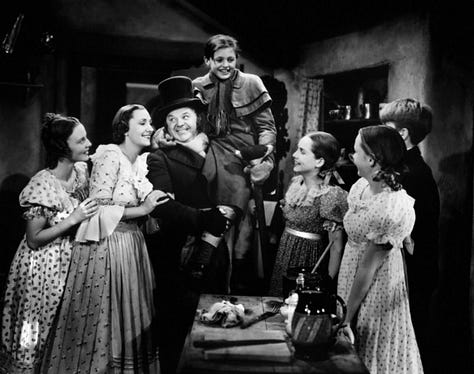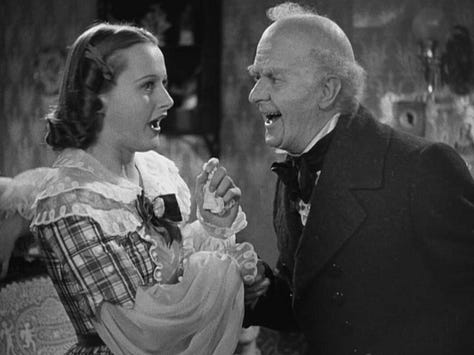A CHRISTMAS CAROL
1938 • Edwin L. MarinCast: Reginald Owen, Gene Lockhart, Kathleen Lockhart, Terry Kilburn, Barry MacKay, Lynne Carver, June Lockhart, Leo G. Carroll, Ann Rutherford, Lionel Braham
Screenplay: Hugo Butler; Based on A Christmas Carol 1843 novella; by Charles Dickens
Cinematography: Sidney Wagner, John F. Seitz
Music: George Boemler
Producer: Joseph L. Mankiewicz
Metro-Goldwyn-Mayer
It was for your welfare that I made this visit, Ebenezer Scrooge.
Edwin L. Marin’s classic adaptation of Charles Dickens's timeless holiday tale. In case you’re the only person left alive that doesn’t know the story, the film follows the heartwarming and redemptive journey of Ebenezer Scrooge, a miserly and cold-hearted old man, as three spirits visit him on Christmas Eve. Set in Victorian London, the story begins with Scrooge (Reginald Owen) showing contempt for the festive season and disdain for the joyous spirit that surrounds Christmas. His sole focus is on accumulating wealth, and he dismisses the pleas of his underpaid employee, Bob Cratchit (Gene Lockhart), for a day off to celebrate with his family. As the night progresses, Scrooge is visited by three ghosts: The Ghost of Christmas Past, who takes him on a haunting journey through his own history, revealing the choices and events that led him to his current state of bitterness. The Ghost of Christmas Present then transports Scrooge to witness the joy and warmth of those celebrating Christmas in the present, including the Cratchit family and Scrooge's nephew, Fred (Barry MacKay). Finally, the Ghost of Christmas Yet to Come, or the Ghost of Christmas Future, reveals a grim vision of Scrooge's lonely death and the impact it has on those around him. Will the ghosts make Scrooge change his ways, or is his redemption impossible?
Before this landmark production, earlier adaptations of the timeless tale were limited to short films produced during the silent era of cinema. These silent films, while capturing the essence of Dickens' story, were constrained by the limitations of their format, often running only a few minutes in duration. The transition from short silent films to a full-length feature marked a significant milestone in bringing A Christmas Carol to the big screen. The 1938 adaptation allowed for a more comprehensive and detailed exploration of Dickens' narrative then there had been before on screen. With the extended runtime, a whopping 69 minutes, the filmmakers were able to delve into the nuances of Scrooge's character, his past, present, and future, as well as the rich tapestry of Victorian London during the holiday season. This feature-length format also provided the opportunity to showcase the depth and complexity of the supporting characters, such as Bob Cratchit and Tiny Tim, and to highlight the social commentary that Dickens embedded in his work. The film's longer duration allowed for a bigger impact when Scrooge finally achieves redemption. As a result, when people reflect on the cinematic history of A Christmas Carol, the 1938 film is often recognized as the first comprehensive adaptation, setting the standard for future retellings of Dickens' classic tale.
Reginald Owen's portrayal of Ebenezer Scrooge is significant in the history of Christmas Carol’s cinematic adaptations. Reginald Owen was not the first actor to portray Ebenezer Scrooge on film, but he was the first actor to do it for a major motion picture studio, MGM. Originally this version was to star Lionel Barrymore, who had done the role many times before on radio. Barrymore's familiarity with the character made him an ideal choice, but unfortunately, health issues forced him to step down from the role. In his absence, Reginald Owen stepped in to fill the shoes of the miserly old man. Owen's performance showcased his ability to embody the essence of Scrooge with a unique charm. While he may not be universally hailed as the definitive on-screen Scrooge, his interpretation is often appreciated for the genuine and rapid transformation his character undergoes.
As Scrooge is confronted by the Ghost of Christmas Yet to Come and shown the bleak future that awaits him, Owen skillfully conveys the emotional weight of the character's realization. Owen's Scrooge is visibly shaken and haunted by the gravity of the impact his life has on others, and this realization brings about a profound transformation in his demeanor. The once stoic and miserly old man now appears vulnerable, reflecting a deep sense of regret for the choices he has made throughout his life. Owen captures the essence of Scrooge's internal struggle as he grapples with the profound loneliness and isolation that awaits him if he continues on his current path. Owen's performance in these critical scenes contributes significantly to the emotional impact of the film and reinforces the overarching message of redemption and the transformative power of Christmas. Owen's portrayal captures the heart of Scrooge's redemption, emphasizing the joy and love that Christmas can bring even to the coldest of hearts.
What's interesting about this adaptation, is despite being the first major filmed version of the story, it perhaps takes the most departures from the original narrative than other classic versions. This actually works in its favor. Pretty much everyone knows the story of Dickens' classic by heart, but since this version actually changes a few details it makes it a little more charming than other versions. It's easier to get lost in a story you've seen 100 times. Fred and the Cratchit's get more screentime in this version, which helps Scrooge's transformation have more impact. One notable departure lies in the increased focus on characters like Fred and the Cratchits. By giving them more screen time, the filmmakers provide a deeper exploration of their lives and relationships. This decision not only enriches the overall narrative but also enhances the impact of Scrooge's transformation. Audiences get to witness more intimately the warmth and love present in the Cratchit family, as well as the genuine goodwill exhibited by Scrooge's nephew, Fred. These expanded character arcs contribute to a more emotionally resonant storytelling experience. However, nothing is changed that radically affects the story you already know. The 1938 adaptation's ability to maintain the core spirit of Dickens' work while introducing these nuanced changes speaks to the adaptability and enduring appeal of A Christmas Carol.
The film concludes with a reformed Scrooge spreading love and cheer, proving that even the coldest of hearts can thaw with the magic of Christmas. The 1938 adaptation of A Christmas Carol remains a cherished holiday classic, capturing the essence of Dickens' timeless tale and delivering a message of redemption, goodwill, and the power of love and kindness.
- Please let me stay!
- Nonsense! You don't want to stay!
- Yes, I do!
- No! You don't like Christmas!
- Yes! Yes, I do! I like Christmas! I LOVE Christmas!
Streaming: MAX, Roku, Watch TCM
Digital Rental/Purchase: Available at most digital retailers
Physical Media: Available on Blu-Ray and DVD
